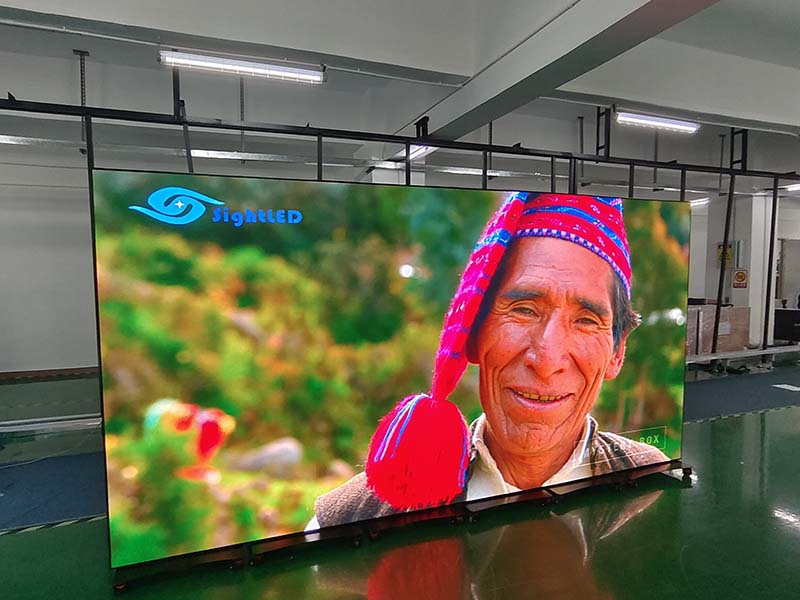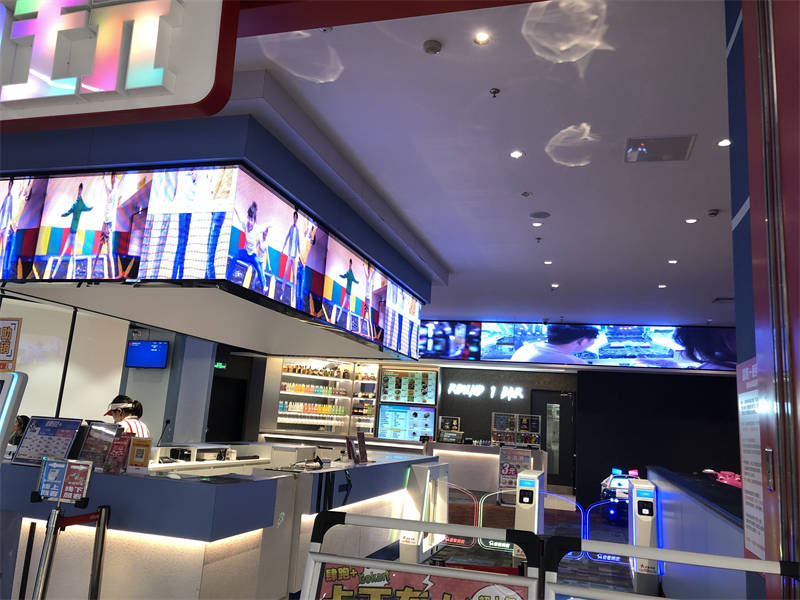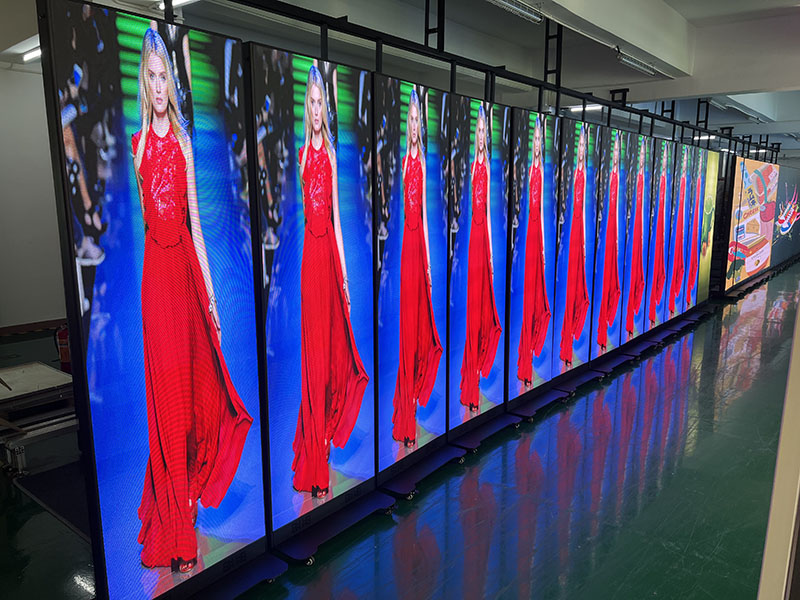In the field of display technology, small-pitch LED display screens have the advantages of high brightness, high resolution, and high definition. They have been widely used in many occasions, such as monitoring command centers, conference rooms, exhibitions, etc. However, in order to provide a better viewing experience for the audience. You need to accurately calculate the viewing distance. SightLED will introduce these details to you.
Table of Contents
ToggleThe practical application significance of visual distance calculation

In practical applications, it is of great significance to accurately calculate the viewing distance of small-pitch LED display screens.
- For the monitoring command center, a reasonable visual distance setting allows staff to clearly see the details in the monitoring screen and make accurate decisions in time.
- In the conference room scene, the appropriate visual distance allows participants to watch the presentation content comfortably and improve meeting efficiency.
- In exhibitions and displays, by reasonably adjusting the visual parameters of the LED display screen according to the audience’s viewing position and distance, it can attract the audience’s attention and improve the display effect.
So how to calculate the viewing distance?
The basis of human eye resolution

The theoretical resolution of the human eye is 20 arc seconds, but due to the distribution of photoreceptor cells and their own defects, the actual resolution of visible light is 1 arc minute. Therefore, objects with a width of more than 1 arc minute will blend into the background and are difficult to distinguish clearly.

1 arc minute converted to radians is 1/60 degrees, that is, (2π/360)/60 ≈ 0.000291 radians, usually 0.000294 radians.
Based on this principle, we can calculate the minimum point distance that the human eye can distinguish at a specific distance.
Taking 1 meter as an example, the minimum point distance that the human eye can see (approximately equal to the arc length) can be calculated by the formula:
“Arc length = radian * radius”.
Here:
- The radius is 1000mm
- the radian is 0.000291
- Then the arc length = 0.000291 * 1000mm = 0.291mm.
This data provides an important basis for our subsequent calculation of the viewing distance.
Visual perception of viewing distance using a flat-screen TV as an example
In order to more intuitively understand the relationship between viewing distance and display effect, we take a 16:9 high-definition (resolution 1920×1080) flat-screen TV screen as an example for calculation.
Through relevant calculations, we know that:
| Distance (meters) | Screen Size (inches) |
|---|---|
| 1 | 25.237 |
| 2 | 50 |
| 3 | 75 |
| 4 | 100 |
| 5 | 125 |
From these data, it can be seen that as the viewing distance increases, in order to ensure the viewing effect, the required screen size also needs to be increased accordingly. Therefore, this also reflects from the side that for LED display screens, there is a close connection between viewing distance and screen size. However, this connection is also applicable to the calculation of the viewing distance of small-pitch LED display screens.
Definition and formula derivation of optimal viewing distance

Definition of optimal viewing distance
The optimal viewing distance is defined as the minimum distance at which the two nearest adjacent pixel points cannot be distinguished in the normal direction of the front of the screen. That is to say, in the visible area beyond the optimal viewing distance, the audience can see a highly clear image and will not feel the graininess of the screen, because the resolution limit of the human eye has been reached at this time.
Formula derivation
Based on the resolution ability of the human eye, we derive the calculation formulas for the minimum viewing distance S1, the maximum viewing distance S2 and the optimal viewing distance Sr.
Among them,
- Minimum viewing distance S1 = 3400H,
- Maximum viewing distance S2 = 3400P,
- Optimum viewing distance Sr = 1 + 0.618(S2 – S1).
Here :
- P (mm) represents the LED pixel spacing
- H (mm) represents the three-color LED particle spacing.
The derivation process of the above formula fully considers the resolution characteristics of the human eye and the pixel distribution of the LED display. Through these formulas, we can accurately calculate the viewing distance range of the LED display according to the specific parameters of the LED display, such as pixel pitch, so as to provide a scientific basis for practical applications.
| Pixel Pitch (mm) | Pixel Structure | Minimum Viewing Distance (mm) | Optimal Viewing Distance (mm) | Maximum Viewing Distance (mm) |
|---|---|---|---|---|
| 0.9375 | SDM0606 | 680.00 | 2229.64 | 3187.50 |
| SMD0808 | 906.67 | 2316.22 | 3187.50 | |
| 1.25 | SMD0808 | 906.67 | 2972.85 | 4250.00 |
| SMD1010 | 1133.33 | 3059.43 | 4250.00 | |
| 1.499 | SMD0808 | 906.67 | 3496.05 | 5096.60 |
| SMD1010 | 1133.33 | 3582.63 | 5096.60 | |
| 1.667 | SMD1010 | 1133.33 | 3935.63 | 5667.80 |
| 1.875 | SMD1010 | 1133.33 | 4372.68 | 6375.00 |
| SMD1515 | 1700.00 | 4589.15 | 6375.00 | |
| 1.923 | SMD1010 | 1133.33 | 4473.54 | 6538.20 |
| 2.00 | SMD1010 | 1133.33 | 4635.33 | 6800.00 |
| 2.5 | SMD1010 | 1133.33 | 5685.93 | 8500.00 |
| SMD1515 | 1700.00 | 5902.40 | 8500.00 |
The impact of actual viewing conditions on human eye resolution
The above-mentioned human eye resolution of 1 arc minute is tested for black bars on white paper under very ideal conditions (sufficiently bright sunny days, and no reflections), and is obtained by people with particularly good eyesight. However, in real life, viewing conditions often cannot reach such an ideal state.
Under dim lighting, the human eye’s resolution will deviate from the ideal value. Moreover, the human eye is more sensitive to this pattern. In a dim environment, the human eye’s ability to resolve white dots on a black background will reach 3 to 5 times that of black bars on white paper.
In addition, for point light sources in dim light (if the brightness of the point light sources is the same, such as astronomical binary star observations), the best resolution can reach 2 arc minutes, and the resolution of ordinary people in this case is 3-5 arc minutes. If the audience is myopic, the resolution of distant objects will be lower.
These actual situations show that when calculating the viewing distance of small-pitch LED display screens, we cannot only rely on the human eye’s resolution under ideal conditions, but also need to fully consider factors such as the actual viewing environment and individual differences of the audience, and make appropriate adjustments to the calculation results.
From the above, we can easily choose a right small-pitch LED screen. However, after choosing the pitch, we also need to consider its system characteristics and functions, such as:
Display function
The small-pitch LED display has rich display functions. In terms of video signal display, all monitoring video signals (compatible with PAL/NTSC/SECAM formats) connected to the network distributed processor can be displayed on the large screen in real time at the same time.
You can realize splicing display, display of any size, arbitrary scaling, roaming, full screen and other display functions, and can realize group switching, inspection, plan display and other functions of video signals.
For computer and workstation DVI/RGB signal display, all computer and workstation DVI/RGB signals connected to the network distributed processor can automatically adapt to the resolution.
All DVI/RGB signals can be displayed on the large screen at the same time, and real-time and delay-free display can be achieved. Splicing display, display of any size, arbitrary scaling, roaming and other display functions can also be achieved.
The network distributed processor also supports the real-time display of static ultra-high-resolution images and real-time dynamic GIS, GPS, SCADA, and SIG ultra-high-resolution graphic signals in any size up to the full screen, as well as the superimposed display with computer RGB and video signals. And the image of the whole screen will not lose clarity regardless of size.
System Features
SightLED’s small-pitch LED display system is guided by theories such as system engineering, information engineering, and automatic control, integrating the world’s most outstanding high-definition digital display technology, splicing technology, multi-screen image processing technology, and network technology.
You can make the entire system a large-screen display system with high brightness, high resolution, high definition, high intelligent control, and advanced operation.
Our system can also be well connected and integrated with user monitoring systems, command and dispatch systems, network information systems, etc. to form a set of functionally complete and technologically advanced interactive information display and management platforms.
In order to allow small-pitch LED displays to play a greater role in complex application scenarios, higher requirements are also placed on the accurate calculation of viewing distance.
Conclusion
The visual distance calculation of small-pitch LED display is a complex problem involving many factors such as human eye resolution, display parameters and actual viewing environment.
In practical applications, we should consider all the above factors comprehensively. With the continuous development of display technology, small-pitch LED display screens are becoming more and more high-definition. If you need a small-pitch LED screen and don’t know how to choose, you can contact us at will.







